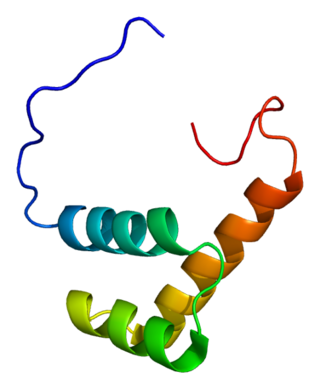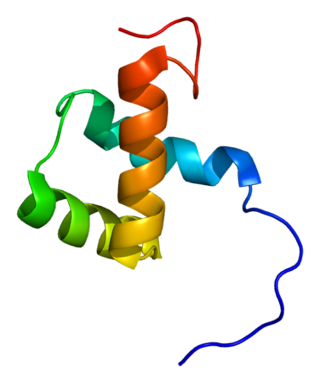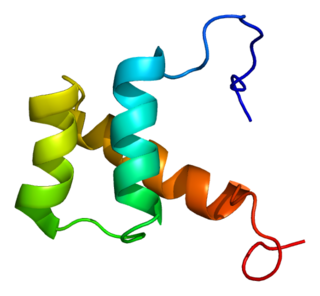Homeobox protein MSX-2 is a protein that in humans is encoded by the MSX2 gene. [4] [5] [6]
Homeobox protein MSX-2 is a protein that in humans is encoded by the MSX2 gene. [4] [5] [6]
This gene encodes a member of the muscle segment homeobox gene family. The encoded protein is a transcriptional repressor whose normal activity may establish a balance between survival and apoptosis of neural crest-derived cells required for proper craniofacial morphogenesis. The encoded protein may also have a role in promoting cell growth under certain conditions and may be an important target for the RAS signaling pathways. Mutations in this gene are associated with parietal foramina 1 and craniosynostosis type 2. [6] Msx2 is a homeobox gene localized on human chromosome 5 that encodes a transcription repressor and activator (MSX-2) responsible for craniofacial and limb-bud development. Cells will express msx2 when exposed to signaling molecules BMP-2 and BMP-4 in situ. [7] Expression of msx2 leads to the proliferation, migration and osteogenic differentiation of neural crest cells during embryogenesis and bone fracture. [8] It is well documented that expression of cell-cell adhesion molecules such as E-cadherins will promote structural integrity and an epithelial arrangement of cells, while expression of N-cadherin and vimentin promote mesenchymal arrangement and cell migration. [9] [10] Msx2 downregulates E-cadherins and upregulates N-cadherin and vimentin which indicates its role in inducing epithelial mesenchymal transition (EMT). Germline knockout mice have been created for this gene (Msx2 +/-) in order to examine functional loss. [11] Clinical studies on craniosynostosis, or the premature fusion of cranial structures, have shown the condition to be genetically linked to mutation in the msx2 homeobox gene. [12]
Msh homeobox 2 has been shown to interact with DLX5, [13] DLX2 [13] and MSX1. [13]

A homeobox is a DNA sequence, around 180 base pairs long, that regulates large-scale anatomical features in the early stages of embryonic development. Mutations in a homeobox may change large-scale anatomical features of the full-grown organism.

Twist-related protein 1 (TWIST1) also known as class A basic helix–loop–helix protein 38 (bHLHa38) is a basic helix-loop-helix transcription factor that in humans is encoded by the TWIST1 gene.

Zinc finger E-box-binding homeobox 2 is a protein that in humans is encoded by the ZEB2 gene. The ZEB2 protein is a transcription factor that plays a role in the transforming growth factor β (TGFβ) signaling pathways that are essential during early fetal development.

HNF1 homeobox A, also known as HNF1A, is a human gene on chromosome 12. It is ubiquitously expressed in many tissues and cell types. The protein encoded by this gene is a transcription factor that is highly expressed in the liver and is involved in the regulation of the expression of several liver-specific genes. Mutations in the HNF1A gene have been known to cause diabetes. The HNF1A gene also contains a SNP associated with increased risk of coronary artery disease.

Pre-B-cell leukemia transcription factor 1 is a protein that in humans is encoded by the PBX1 gene. The homologous protein in Drosophila is known as extradenticle, and causes changes in embryonic development.

Homeobox protein MSX-1, is a protein that in humans is encoded by the MSX1 gene. MSX1 transcripts are not only found in thyrotrope-derived TSH cells, but also in the TtT97 thyrotropic tumor, which is a well differentiated hyperplastic tissue that produces both TSHß- and a-subunits and is responsive to thyroid hormone. MSX1 is also expressed in highly differentiated pituitary cells which until recently was thought to be expressed exclusively during embryogenesis. There is a highly conserved structural organization of the members of the MSX family of genes and their abundant expression at sites of inductive cell–cell interactions in the embryo suggest that they have a pivotal role during early development.

Paired-like homeodomain transcription factor 2 also known as pituitary homeobox 2 is a protein that in humans is encoded by the PITX2 gene.

Homeobox protein Hox-A1 is a protein that in humans is encoded by the HOXA1 gene.

Zinc finger E-box-binding homeobox 1 is a protein that in humans is encoded by the ZEB1 gene.

Cone-rod homeobox protein is a protein that in humans is encoded by the CRX gene.

Homeobox protein Hox-A11 is a protein that in humans is encoded by the HOXA11 gene.

Homeobox protein DLX-5 is a protein that in humans is encoded by the distal-less homeobox 5 gene, or DLX5 gene. DLX5 is a member of the DLX gene family.

Homeobox protein DLX-4 is a protein that in humans is encoded by the DLX4 gene.

Homeobox protein Hox-C4 is a protein that in humans is encoded by the HOXC4 gene.

Paired-like homeodomain 1 is a protein that in humans is encoded by the PITX1 gene.

Homeobox protein MOX-2 is a protein that in humans is encoded by the MEOX2 gene.

Homeobox protein DLX-2 is a protein that in humans is encoded by the DLX2 gene.

Transcription factor Sp7, also called osterix (Osx), is a protein that in humans is encoded by the SP7 gene. It is a member of the Sp family of zinc-finger transcription factors It is highly conserved among bone-forming vertebrate species It plays a major role, along with Runx2 and Dlx5 in driving the differentiation of mesenchymal precursor cells into osteoblasts and eventually osteocytes. Sp7 also plays a regulatory role by inhibiting chondrocyte differentiation maintaining the balance between differentiation of mesenchymal precursor cells into ossified bone or cartilage. Mutations of this gene have been associated with multiple dysfunctional bone phenotypes in vertebrates. During development, a mouse embryo model with Sp7 expression knocked out had no formation of bone tissue. Through the use of GWAS studies, the Sp7 locus in humans has been strongly associated with bone mass density. In addition there is significant genetic evidence for its role in diseases such as Osteogenesis imperfecta (OI).

Iroquois-class homeodomain protein IRX-5, also known as Iroquois homeobox protein 5, is a protein that in humans is encoded by the IRX5 gene.

Homeobox protein NOBOX, also known as newborn ovary homeobox protein, is a protein that in humans is encoded by the NOBOX gene. The official symbol (NOBOX) and the official full name are maintained by the HGNC. The NOBOX gene is conserved in chimpanzee, Rhesus monkey, cow, mouse, and rat. There are 175 organisms that have orthologs with human gene NOBOX. It is capable of regulating other genes that are important in the development of follicles. Follicles do not develop and oocytes decrease in its absence which lead to infertility.
This article incorporates text from the United States National Library of Medicine, which is in the public domain.